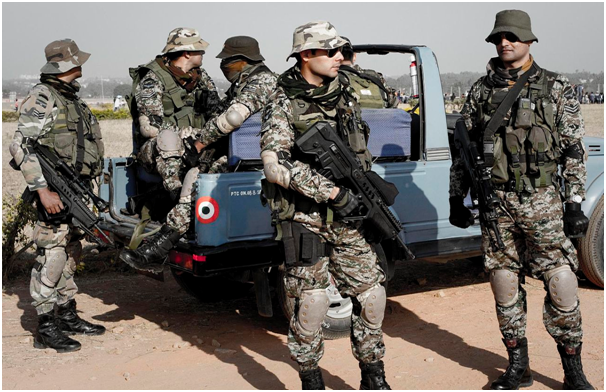MODI GOVT BREAKS SPECIAL FORCES RULE OF STEALTH, SECRECY, SILENCE
Garud commandos of the Indian Air Force

NEW DELHI: Covert operations, like the one conducted in Myanmar on Tuesday need to remain covert, is the unstated maxim of all such activity.
But in their zeal to politicise even clandestine missions to garner support for a flagging administration, the Modi government has broken the cardinal rule of all Special Forces (SF) missions around the world: stealth, secrecy and above all, silence.
And though the 21 Parachute Regiment (SF) observed the first of this three-part dictum, the other two rules have been flagrantly flaunted by the higher security established.
The jingoism adorning the front pages of this monrings national newspapers even went to the extent of parading a group picture of the SF that participated in the raid on two insurgent camps inside Myanmar.
One publication even gratuitously declared-under tutelage by the authorities- that the assault team comprised soldiers with mongoloid features from the northeast so that they could ‘meld’ with the rebels.
Facial features being a pre-requisite for military missions seem a new and somewhat novel Indian Army tactic if this assertion is, indeed, true.
Officials involved in planning the raid provided detailed briefings to reporters of the entire operation, a blow-by-blow execution of the attack and of the assets and tactics employed.
Television news channels went berserk assuming a self-congratulatory nationalistic tone, over an event that at best was an average-sized operation and one that could easily have been conducted by the Infantry’s Ghatak or commando platoons.
Even the intelligence feeds into the mission-unmanned aerial vehicles and information from local tribal folk, populating the porous jungle region between Myanmar and Manipur and Nagaland-have all been laid bare by the security establishment.
If there is one aspect that definitely needs not to be divulged is the intelligence aspect, especially as the government has screamingly declared that it plans similar attacks on other militant camps inside Myanmar. It’s a no brainer that these sites will now be deserted and their inmates wary not of UAV surveillance but also of local fellow tribesmen.
If all this was not stupid enough, junior information minister Rajyavardhan Singh Rathore took the charade a step further. Specially briefed by security officials he was let loose on television channels to tom-tom the entire SF clandestine operation, whilst Defence Minister Manohar Parrikar was missing.
His sole qualification for doing so was his former career in the army, albeit one that included little soldering but more trap shooting.
Rathore’s remit was also to issue a laughable warning to Pakistan, China and all other neighbouring countries to be mindful of India’s newfound political and military muscle.
No doubt, both nuclear rivals are catatonic with fear, if one were to believe the chauvinistic media, following Rathore’s ‘ stern message to India’s neighbours’.
The other aspect that has been blithely ignored is how the political and military establishment have dominated a pliant media to mindlessly perpetuate their propaganda.
En masse the media-print and electronic-has largely glossed over the ambushing of the army convoy in Manipur’s Chandel district on 4 June and the gross violation by it of standard operating procedures (SOP).
In total disregard to security, the 6 Dogra convoy had neither a machine gun mounted quick reaction vehicle at the front and rear of the moving column, it had also crammed an inordinately large number of soldiers into one, unprotected vehicle.
What is even more shocking is that the units movement was being overseen by a junior commissioned officer; the commanding officer was on leave whilst hissecond-in-command had taken the battalions advance party to Chandigarh, its place of transfer.
The more dramatic news of the SF operations in Manipur, spoon-fed to the media, has supplanted these unforgivable SOP violations, successfully shifting the focus from the commuting battalions original sin.
No doubt there will be court of inquiry followed, possibly by court martial proceedings but, if current indications are a pointer, these too are likely to be glossed over.
Meanwhile, it does little credit to National Security Adviser Ajit Doval, a former Intelligence Bureau operative, reportedly with a penchant for clandestine missions, to preside over an operation that errs on the side of transparency rather than silence.
The Indian Army’s subtle statement on the operation was ideal. It conveyed the message firmly and the entire matter should have ended there.
Instead, the publicity and self-congratulatory crowing resulted in the Myanmar government denying that the raid had taken place inside its territory.
It’s obvious that the Myanmar authorities were complicit in the operations, provided it was kept under wraps, but India’s public admission of the undercover strike compulsorily forced its denials.
Similar Indian Army operations against northeastern militant groups along the Myanmar border in 1995 (Operation Golden Bird) and Operation All Clear inside Bhutan in 2003, accompanied no such hype and hysteria.
Those were clinical strikes, conducted by the army and its details are, expectedly, locked away in some secret file, as they should and known only a few tightlipped officials.
Comparisons with the US Navy SEALs raid on Osama bin Laden’s hideout in Abbotabad in May 2011 are obvious, but the secrecy surrounding this awesome mission remains, leaving the enemy guessing.
India’s security establishment under PM Modi, however, simply believes that if you’ve done it, flaunt it.



